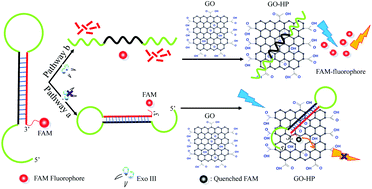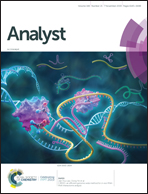A graphene oxide-based fluorescence assay for the sensitive detection of DNA exonuclease enzymatic activity
Abstract
The 3′–5′ exonuclease enzyme plays a dominant role in multiple pivotal physiological activities, such as DNA replication and repair processes. In this study, we designed a sensitive graphene oxide (GO)-based probe for the detection of exonuclease enzymatic activity. In the absence of Exo III, the strong π–π interaction between the fluorophore-tagged DNA and GO causes the efficient fluorescence quenching via a fluorescence resonance energy transfer (FRET). In contrast, in the presence of Exo III, the fluorophore-tagged 3′-hydroxyl termini of the DNA probe was digested by Exo III to set the fluorophore free from adsorption when GO was introduced, causing an inefficient fluorescence quenching. As a result, the fluorescence intensity of the sensor was found to be proportional to the concentration of Exo III; towards the detection of Exo III, this simple GO-based probe demonstrated a highly sensitive and selective linear response in the low detection range from 0.01 U mL−1 to 0.5 U mL−1 and with the limit of detection (LOD) of 0.001 U mL−1. Compared with other fluorescent probes, this assay exhibited superior sensitivity and selectivity in both buffer and fetal bovine serum samples, in addition to being cost effective and having a simple setup.



 Please wait while we load your content...
Please wait while we load your content...
